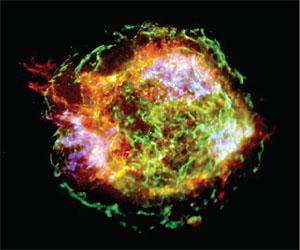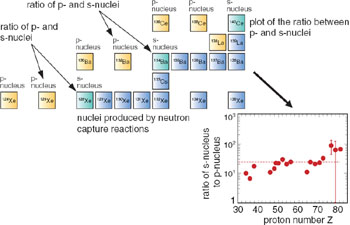Light elements such as hydrogen were synthesized by the Big-Bang ca. 1.4×1010 y ago. Heavy elements were produced by stellar nuclear reactions after the formation of the Galaxy. The synthesized elements (Fig. 5-1) were accumulated among interstellar materials (ISM). The Solar System was born from the ISM ca. 4.6×109 y ago. Thus understanding the origins of the heavy elements in the Solar System contributes to study the galactic chemical evolution (GCE) as well as the origin of the Solar System.
About 99% of elements heavier than iron are synthesized by two-neutron capture-reactions, s- and r-processes. However, the origin of p-nuclei has been an open problem. The p-nuclei are rare isotopes located at the proton-rich side in the nuclear chart. For the origin of the p-nuclei, high-energy cosmic-ray nucleo-synthesis, X-ray bursts in neutron stars and photodisintegration reactions in supernovae (Fig. 5-2) have been proposed.
We find an empirical law in the solar system abundance. Eighteen pairs of p- and s-nuclei exist. The s-nucleus is two heavier than the p-nucleus, as shown in Fig. 5-3. Taking the abundance ratio of the s-nucleus to the p-nucleus, we find the law that "the abundance of the s-nucleus / the abundance of the p-nucleus = 23." This law is evidence that the p-nuclei are synthesized from the seed s-nuclei by photodisintegration reactions (Fig. 5-2). In addition we find calculations (using the best SN model based on new astronomical observations) can reproduce this empirical law.
The scaling law is evidence of the origin of the p-nuclei and contributes to understanding the GCE. |


